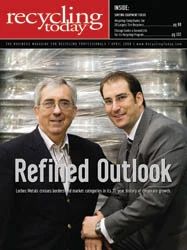More municipalities across the nation have been adding direct mail advertisements containing mailing labels, window envelopes and brightly dyed paper to their curbside collections. Keep in mind, however, that the amount of bulk mail collected through curbside programs is minute compared to the bulk mail material recovery facilities (MRFs) receive from the U.S. Post Office.
One would think such bulk mail advertisements would be an unwelcome addition to a MRF’s operation. On the contrary, MRFs say that junk mail has had little effect on their operations because they do not receive a significant amount of it. According to Steve Grossman, president of the Grossman Group, Columbus, Ohio, less than 2 percent of municipally collected paper is junk mail. If you include magazines, newsprint flyers, etc., the volume of junk mail MRFs receive increases to between 5 percent to 7 percent.
The operations most feeling the heat from the addition of junk mail to curbside collection containers are paper mills that purchase bales of material from MRFs. While some MRF operators may say junk mail makes up less than 2 percent of their incoming material, for newsprint mills, even this small percentage of junk mail can be detrimental to their equipment and final products. Paper mills such as SP Newsprint consider junk mail to be a contaminant that is not welcome in their pulping process because it can decrease the quality of the paper these mills are shipping to their customers.
While most paper mills can handle a small amount of direct mail, their problems begin when they start receiving large quantities of it. What is a reasonable amount and how can mills reduce contamination? At the end of the day, these are questions mills are left pondering.
A WECOME ADDITIONMany MRFs view junk mail as an opportunity to capture more fiber, and a number of municipalities find that collecting the material helps them in their efforts to reach specified diversion rates.
"The actual percentage of contamination, such as plastic window envelopes, is small in comparison to the percentage of newsprint and other excellent fiber," Grossman says. "The fiber content of junk mail is actually very good and tends to improve the quality of ONP (old newsprint)," he adds.
Most MRFs mix junk mail in with ONP that is going to insulation producers or to export or deinking newsprint mills.
Because MRFs often mix junk mail in with ONP, their operations don’t need to change much to accommodate this material. MRFs can follow a simple sorting procedure, according to Grossman, that includes putting white and lightly colored junk mail into the ONP and brown and darkly colored papers with corrugated containers (OCC). Colored and some white flyers can be made of ground wood or coated stock. If coated stock is included, it is actually a plus for mill consumers, as it can aid deinking mills with floatation, Grossman adds.
City Carton Recycling’s Cedar Rapids, Iowa, facility uses a sorting system that consists of three screens that mechanically separate newspaper from other types of paper based on size. Less than 1 percent of the ONP the company sends out is junk mail, and only 6.5 percent of the mixed paper it ships is junk mail, according to Chris Ockenfels, northern division manager, City Carton Recycling, headquartered in Iowa City, Iowa.
Most MRFs agree that an increase in junk mail into their facilities could have an impact on their paper shipments to certain consumers. Joel Cornell, plant operations manager, Ecosource, Georgia-Pacific, Green Bay, Wis., says junk mail can have a negative effect on the quality of ONP shipments, turning them into a mixed paper grade if they are not properly sorted.
This is where junk mail starts to become a problem for MRFs. If a mill that thinks it is going to receive a load of ONP instead gets a load of mixed paper, it can reject the shipment, costing the MRF valuable time and money. Or, worst case scenario, the mill will discontinue buying material from that MRF.
To prevent paper quality issues like this from arising, Ockenfels had an optical sorting system installed at City Carton’s Cedar Rapids facility to help the company sort out even more unwanted material.
PAPER PESTSJunk mail may only make up 1 to 2 percent of a MRF’s overall incoming material stream, but to a paper mill, 1 to 2 percent is all it takes to damage its systems and contaminate its final product. "We use 2,200 tons of ONP a day, and if 1 percent of that is junk mail, that means 22 tons of junk mail gets into our deinking and cleaning systems everyday," says Ralph Simon, vice president of SP Recycling, a division of SP Newsprint, Atlanta.
Mills such as SP Newsprint are now faced with a greater variety of incoming fibers as well as increased levels of contamination from glues, coatings, etc., which are difficult to remove in the papermaking process, says John Lucini, Pacific Region vice president, SP Newsprint Recycling, who is based in Oregon.
The variety of sizes among incoming junk mail also makes the material difficult to screen out and remove, according to SP’s Simon. "There is a variety of material that can be included in ‘junk mail,’ and it is an inconsistent commodity," he says. "Mills need material that is reliable and consistent."
Simon adds that MRFs can receive tens of thousands of pounds of commingled material that is sorted by conveyors moving at 100 feet per
| Testing New Waters |
|
As the number of individuals working from home offices continues to rise, material recovery facilities (MRFs) have been seeing an increasing amount of shredded paper coming through their facilities. MRFs, such as the ones City Carton Recycling, Cedar Rapids, Iowa, operates are turning to equipment manufacturers to help them clean up their shredded paper. "We currently are capturing roughly 80 percent of shredded paper, and the other 20 percent is too contaminated to sort and must go to the landfill," says Chris Ockenfels, northern division manager, City Carton Recycling, Iowa City, Iowa. City Carton is currently looking at purchasing an air or cyclone system to more efficiently capture shredded paper at its MRF. Because Ockenfels says he believes the number of home offices and small businesses will continue to rise, City Carton is taking hold of these opportunities by starting a shredding program and a valet-style recycling program for small and home-based businesses. "We started these programs to take hold of these markets as well as to capture more volume of this material," Ockenfels says. |
Some newsprint mills ask for household paper, including mail (but not paperboard), but there are others that find this material to be undesirable because of its contaminants, according to Bill Moore, president of Atlanta-based Moore & Associates, an international consulting firm for the paper recycling industry. Mills can handle some junk mail while pulping, but if they get in excessive amounts, it can not only degrade the quality of the final product, but also put an extra burden on cleaning and screening systems, Moore says.
The biggest problem mills have to deal with is plastics, Ockenfels says. "On the MRF side, window envelopes and other plastic material, such as bottle lids, can flip through the screening process and be missed during the final pick and, therefore, can end up in a mill’s shipment," Ockenfels says. Plastic windows are an issue because when they are separated out of the mills’ cleaning systems, mills have to find a way to dispose of them, Moore says. This usually means transporting the material to a landfill, he adds.
Along with plastic window envelopes, mills also have issues with the glues that are used on stamps and self-adhesive labels. "The non-water-soluble glues found on mailing labels and stickies are killers because they can get on the rolls of the paper machine, in the wires and screens, plugging up the equipment," Moore says. "And depending on the type of glue that was used on the label, it could make it all the way through the cleaning process and end up in the final product," he adds.
Simon agrees that glues and adhesives are a major concern for paper mills. These contaminants are difficult and costly to remove from the cleaning and pulping process. "The glue separates when it gets hot, but then comes back together when it cools, forming stickies that could get on the paper machine felts and screens or even into the paper itself," Simon says.
It doesn’t seem mills and MRFs will come to an agreement on the issue of junk mail any time soon. MRFs will continue to capture junk mail, as it adds volume to their facilities and has had little effect on their processes. Also, municipalities want to continue collecting junk mail because it increases their diversion rates. However, on the mill side, junk mail will continue to be perceived as a contaminant, and paper mills face the prospect of continuing to adjust to deal with the material. SP Newsprint has invested in additional cleaning equipment and is focusing more on presorting and removing these contaminants. "The mill’s alternative is ending procurement relationships with those suppliers that provide ONP loads with too much junk mail in bales," Simon says.
What could give mills some relief, according to Simon, is if the materials were kept separate at the curb or if the MRFs and mills worked together to better separate the commingled materials. But, until then, it is still a complicated balancing act in recycling more contaminated paper stock, Simon says.
The author is assistant editor of Recycling Today and can be contacted at kmorris@gie.net.
 | Garden Center is adjusting the way the 2025 Top 100 Independent Garden Centers List is built. This year, for the first time, we are asking all retailers to report annual revenue for *only* their top-performing or flagship location. Submit your IGC for consideration on the list today.
|

Explore the April 2008 Issue
Check out more from this issue and find your next story to read.
Latest from Recycling Today
- Athens Services terminates contract with San Marino, California
- Partners develop specialty response vehicles for LIB fires
- Sonoco cites OCC shortage for price hike in Europe
- British Steel mill’s future up in the air
- Tomra applies GAINnext AI technology to upgrade wrought aluminum scrap
- Redwood Materials partners with Isuzu Commercial Truck
- The push for more supply
- ReMA PSI Chapter adds 7 members







